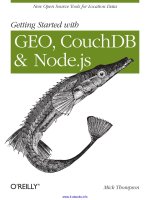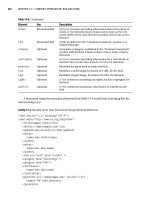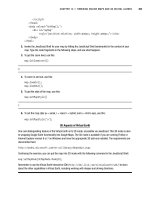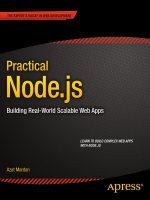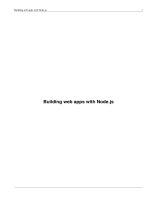Lecture Web technology and online services: Lesson 7.2 - Introduction to Node.js
Bạn đang xem bản rút gọn của tài liệu. Xem và tải ngay bản đầy đủ của tài liệu tại đây (563.05 KB, 17 trang )
Introduction to Node.js
1
Content
Introduction
Installation and Example
Introduction
3
Basic Nodejs
•
Node.js is an open-source and cross-platform JavaScript runtime environment
•
Node.js runs the V8 JavaScript engine, the core of Google Chrome, outside of the browser.
This allows Node.js to be very performant.
•
•
2009: Node.js was created by Ryan Dahl, the first form of npm is created
•
2011: Larger companies adopting Node.js: LinkedIn, Uber,…
•
2015: The Node.js Foundation is born, release Node.js 4
•
2017: Node.js 8, introduces Node.js in its testing suite, officially making Node.js a target for the JS engine
•
2020: Node.js 14, 15
In simple words Node.js is “Server-side JavaScript”.
Node’s goal is to provide an easy way to build scalable
network programs – (from nodejs.org)
Basic Nodejs (cont.)
• A Node.js app is run in a single process, without creating a new thread for every
request.
• provides a set of asynchronous I/O primitives in its standard library that prevent
JavaScript code from blocking – Non-blocking I/O
Example:
❑ Traditional I/O
❑ Non-traditional, non-blocking I/O:
5
When can Node.js do?
• Generate dynamic page content
• Create, open, read, write, delete, close files on server
• Collect form data
• Add, delete, modify data in database
• Etc.
6
When to use Node.js?
• Node.js is good for creating streaming based real-time services, web
chat applications, static file servers, etc.
• If high level concurrency and not worried about CPU-cycles.
• If you are great at writing JavaScript code because then you can use
the same language at both the places: server-side and client-side
7
Installation and Example
8
Installation
•
Node.js can be installed in different ways.
•
Download from Node.js website: />
Installation
•
Node.js can be installed in different ways.
•
On MacOS: from CLI
•
On Ubuntu
Install Node.js and NPM on Windows
Step 1: Download Node.js Installer
navigate to Click the Windows Installer button to
download the latest default version.
11
Install Node.js and NPM on Windows
Step 2: Install Node.js and NPM from Browser
•
Browse to the location where you have saved the file and double-click it to launch >
Run > Next
•
On the next screen, review the license agreement. Click Next if you agree to the terms
and install the software.
•
The installer will prompt you for the installation location. Leave the default location,
unless you have a specific need to install it somewhere else – then click Next.
•
The wizard will let you select components to include or remove from the installation.
Again, unless you have a specific need, accept the defaults by clicking Next.
•
Finally, click the Install button to run the installer. When it finishes, click Finish.
12
Install Node.js and NPM on Windows
Step 2: Verify installation
Open a command prompt (or PowerShell), and enter the following:
The system should display the Node.js version installed on your system. You can do the
same for NPM:
13
Basic Node.js Usage
Create a Node.js file named "myfirst.js", and add the following code:
Save the file on your computer: C:\Users\Your Name\myfirst.js
The code tells the computer to write "Hello World!" if anyone (e.g. a web browser) tries to
access your computer on port 8080.
14
Basic Node.js Usage
Command Line Interface:
Node.js files must be initiated in the "Command Line Interface" program of your
computer. (cmd in Windows)
Navigate to the folder that contains the file "myfirst.js", the command line
interface window should look something like this:
15
Basic Node.js Usage
Initiate the Node.js File
Start your command line interface, write node myfirst.js and hit enter:
Start your internet browser, and type in the address: http://localhost:8080
You will get a "Hello World!" message in return!
16
17
